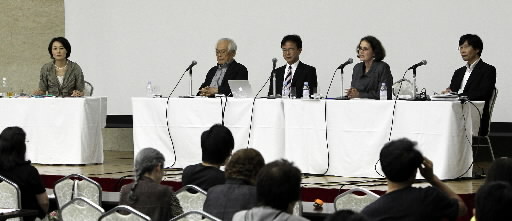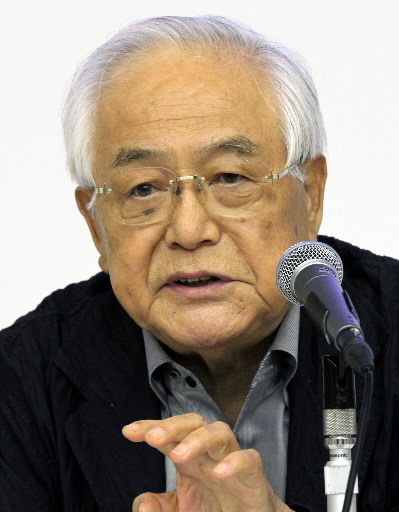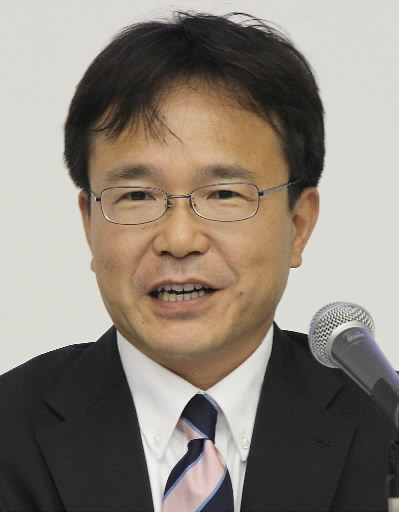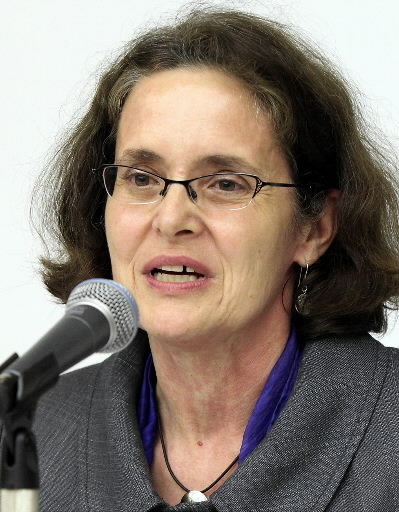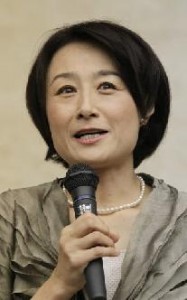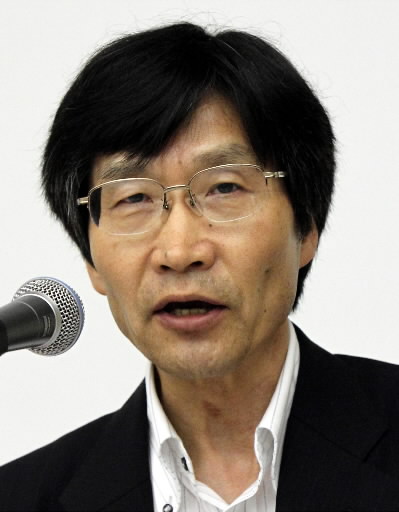Summary of symposium: “From Hiroshima to the World: The Past, Present, and Future of Media Coverage of the Atomic Bombings and Peace Issues”
Jun. 29, 2011
Importance of reporting based on feelings of nuclear victims
A symposium titled “From Hiroshima to the World: The Past, Present, and Future of Media Coverage of the Atomic Bombings and Peace Issues,” organized by the Chugoku Shimbun, was held at the International Conference Center Hiroshima in Naka Ward on June 12. Four panelists, including researchers from Japan and the United States, conducted a discussion on this topic led by moderator Keiko Sugiura, an announcer for the Hiroshima station of NHK (Japan Broadcasting Corporation). About 210 people attended the symposium and expressed their opinions and asked questions. Are Hiroshima’s plea and its media coverage reaching the rest of the world, where nuclear weapons continue to exist? How should the harm resulting from the accident at the Fukushima No. 1 (Daiichi) nuclear power plant, the worst in Japan’s history, be viewed, and what should be done about it? The following are excerpts from the discussion, which lasted approximately two hours.
Panelists
Takashi Hiraoka, former mayor of Hiroshima
Yasuhiro Inoue, professor at Hiroshima City University
Ann Sherif, professor at Oberlin College in the U.S. state of Ohio
Akira Tashiro, executive director of the Hiroshima Peace Media Center
Moderator
Keiko Sugiura, announcer for Hiroshima NHK
Relevance
As a result of the untiring efforts of people to ensure that accounts of the experiences of the atomic bomb survivors are passed on, the atomic bombing of Hiroshima has taken on meaning in terms of the history of humankind. Amid the widening impact of the accident at the Fukushima No. 1 power plant, I would like to ask you about the significance of considering media coverage of the atomic bombings and peace issues.
Hiraoka: As a result of the serious situation at the Fukushima nuclear power plant, I have been thinking about two things. One is that human beings can not control radiation. When it comes to the enormous harm it causes to human beings there is no distinction between military and peaceful uses of nuclear energy. The other is the need to put out accurate information. In Hiroshima during the U.S. Occupation there were restrictions on the presentation of research and on news coverage, and health care and livelihood support for the atomic bomb survivors were delayed. We must learn from this.
Inoue: When I went to the U.S. in late March everyone was talking about the nuclear power plant accident in Fukushima, and the number of students coming to Japan from overseas has fallen dramatically because they are afraid of radiation. The news media are creating a certain image and forming public opinion. Even though the world is linked via the Internet, the news media play an important role, and they are very influential.
Sherif: The news media in the U.S. have not put out accurate information about the horror of the atomic bombing of Hiroshima or about the nuclear accident in Fukushima. If the plea of Hiroshima is to create a world that is not dependent on nuclear technology, it is important to clarify the connection between the atomic bombings and nuclear energy. Ordinary citizens will not be able to judge the risks and benefits of nuclear power if they don’t have reliable information and familiarity with the history of nuclear weapons and subsequent development of peacetime uses of nuclear power.
Tashiro: Even if we convey universal concerns with regard to nuclear issues, as long as the information is in Japanese it can not readily be conveyed to the rest of the world. In 2008 the Chugoku Shimbun created a website devoted to nuclear and peace issues and began putting out information in English, so the effort to provide coverage to the world has just begun.
How should history be viewed?
Sixty-six years have passed since the atomic bombing. How has the news coverage been shaped over the years?
Hiraoka: It has occasionally been restricted and influenced by the political and international situation. From 1945 until the end of the Occupation in 1952 there was a big blank period in the news coverage. The Occupation forces censored news coverage and did not allow the cruelty of the atomic bombings to be known. Reporters did not know enough about the harmful effects of radiation and emphasized the citizens’ desire to rebuild. After the Bikini incident [in which the U.S. military tested a hydrogen bomb] in 1954, the movement to ban the bomb took off. News coverage emphasized the tragedy of the harm caused by the atomic bombings, leading to the passage of the Atomic Bomb Medical Relief Law in 1957. The view of the survivors as “saints” also developed around that time.
So progress has not been without difficulties.
Hiraoka: In the 1970s the atomic bomb survivors on the Korean peninsula, who were caught between governments, began calling for the Japanese government to account for its wartime responsibility. With the end of the Cold War in 1991, people began to consider the relationship between human beings and nuclear weapons. Reports from Hiroshima went from local to national to international news. This played a major role in fostering the desire of the Japanese people for peace and for the abolition of nuclear weapons. But there was not enough coverage that shed light on Japan’s responsibility as the aggressor in the war, U.S. responsibility for the dropping of the atomic bombs or the issue of the Japan-U.S. Security Treaty.
Tashiro: After becoming a reporter I became interested in the fact that there were victims of nuclear testing and of the 1986 accident at the nuclear power plant in Chernobyl. For one year starting in 1989 I was one of the reporters who wrote a series of articles called “Exposure: Victims of Radiation Speak Out” that looked at the situations of victims of nuclear damage in 15 countries. In the early 2000s I traveled around the U.S. and the countries of the former Soviet Union and visited Rokkasho in Aomori Prefecture where there is a plant for the reprocessing of spent nuclear fuel. I published this reportage in a series of articles titled “Negative Legacy of the Nuclear Age” and in my concluding article, I stated that we need to change to an energy policy not dependent on nuclear power plants and get rid of them as soon as possible. I think I anticipated the issues that we have faced up to the present, but the series was not influential enough to bring about a shift in the country’s energy policy.
The broadcasting industry as well has continued to take up the anti-nuclear and peace theme in its coverage. The coverage has reflected the era in which it was produced. By 2003, 50 years after the start of television broadcasting in Japan, more than 500 episodes of “Record of Life in the Nuclear Age,” an NHK special in which I was involved, had been produced. This series provided an overview of nuclear-related issues. Calling on residents to send in “Genbaku no E” (A-bomb Drawings) led to the "Hibakusha kara no Tegami” (Letters from Hibakusha) of recent years, and these are useful in conveying the atomic bombing experience to future generations.
How Hiroshima’s plea is received by the world
How is Hiroshima’s plea received by the world? At the time of the 60th anniversary of the atomic bombing Mr. Inoue investigated media coverage.
Inoue: Coverage differed greatly depending on the country’s historical and political relationship with Japan. There are four interpretations of the dropping of the atomic bomb. The first is the view that the bombings saved lives and brought the war to an end. Leading U.S. newspapers hailed President Truman for this at the time. The second interpretation concerns America’s allies. In Great Britain there was quite a bit of coverage stating that the dropping of the atomic bomb was an atrocity perpetrated against human beings. The front page of France’s Le Monde carried an illustration describing the bombing as the “slaughter of civilians.” In Germany much of the coverage regarded the atomic bombing as a mass murder. The third interpretation is that the bombing was “cruel but for a legitimate goal,” which is the stance taken by Australia. The final interpretation is that Japan got what it deserved. There was a lot of this sort of coverage in newspapers in China and South Korea. It is seen as a question of who started the war and what they did. There was also the interpretation under which the atomic bombings were simply not covered, as was the case with Russia.
How do people in the U.S. view the way the damage caused by the atomic bombings is talked about in Japan?
Sherif: For the past 10 years I have taught a course titled “Living with the Bomb: The Culture of the Nuclear Age” along with a colleague from the American Studies department of my college. At first many students say that the atomic bombings were inevitable events from the distant past. But when they read accounts of survivors and atomic bomb literature that have been translated into English, they develop a sense of empathy for those who experienced the bombings. They are then motivated to learn about the issues of U.S. nuclear weapons and nuclear power. Such-close-up views of the bomb become an incentive to learn about this nuclear age.
What has been the reaction to the accident at the nuclear power plant in Fukushima?
Sherif: Before I came here to participate in this symposium I asked my colleagues and my neighbors about it. Many people are surprised by the situation. They figured that, having experienced the A-bombing of Hiroshima and Nagasaki, Japanese people recognized the horrors of the atom and that, because the country is prone to earthquakes, Japan would not have built nuclear power plants.
Japanese people’s view of peace is “do not make war” and “abolish nuclear weapons.” How do Americans regard peace?
Sherif: Perhaps because the U.S. is a major possessor nation, the news media tend to downplay nuclear weapons. For example, the U.S. media did not report that the U.S. had conducted sub-critical nuclear tests that do not require a test site [last November and in March of this year]. Thanks to the website of the Hiroshima Peace Media Center, however, people in the States are now able to expand their knowledge of nuclear issues and not depend exclusively on the U.S. media. It is important to learn about the reality of nuclear weapons and nuclear power and the history behind them.
Hiraoka: For us it goes without saying that nuclear weapons must be abolished, but I have been rebuffed in this regard three times. The first time was in 1965 when I went back to South Korea, where I spent my teenage years, to do some reporting. Many people said that the dropping of the atomic bomb had liberated them. The second time was in 1995 when, as mayor of Hiroshima, I gave a speech during an exhibition on the atomic bombing at American University in Washington. After the speech, Asian students voiced objections, saying that they were speaking on behalf of their compatriots who had been killed by the Japanese and could not speak for themselves. The third time was in 1998. When I asked the government of India to stop conducting nuclear tests I was told that I should insist to the Japanese government that it get out from under the nuclear umbrella of the U.S.
There are two reasons that Hiroshima’s plea goes unheard. The first is that there is no agreed-upon overview of the war in Japan. It is referred to as the Greater East Asia War or the Asia Pacific War, and in the Diet it is simply called “the past war” because we have not reached agreement on the character of the war. The other reason is the inconsistency of Japan’s stance by which it calls on the international community to abolish nuclear weapons while remaining under the U.S. nuclear umbrella.
How to convey Hiroshima’s plea
What else do you think needs to be done to ensure that Hiroshima’s plea reaches the people of the world?
Tashiro: Since many people in the world still don’t know the real consequences of the atomic bombing, I think we just have to keep up our efforts to inform them. The atomic bomb survivors should travel around the world, and the City of Hiroshima should hold exhibitions on the bombing. With regard to the issues of an overview of the war and the nuclear umbrella as well, we must have a language that will allow us to communicate clearly with those who will receive the information. We should proceed by transmitting reports of substance both within Japan and overseas via the Internet as well.
Sherif: One approach is to communicate the dangers of nuclear weapons and power on a human level. Poetry is a good means of doing that. On the Hiroshima Peace Media Center’s website there is a haiku written by a man who was exposed to the atomic bombing in Hiroshima and had to evacuate as a result of the accident at the nuclear power plant: “I feel the cold spring, driven out of my hometown by an invisible thing.” If people were to read the kinds of articles and haiku featured on the Media Center’s website, they would be able to relate better to Hiroshima and Fukushima.
Inoue: The Internet was developed by the U.S. during the Cold War so that its communications network would not be destroyed even in the event of a nuclear attack by the Soviet Union. It can also be said that the Internet started with the atomic bombing of Hiroshima. If you look at the biggest travel website in the world you find that Miyajima comes out on top in voting for the best spots in Japan, and the Peace Memorial Park and Museum come in second. When you read the comments that have been posted on the site, it is very moving. The young people of the world are spreading the message of Hiroshima on their own. There is no other method but to make use of the Internet like this.
Hiraoka: The abolition of nuclear weapons will not lead to peace. There are many other factors behind threats to peace including poverty, violations of human rights and environmental issues. Before we abolish nuclear weapons we must state what kind of society we will create. In that way, our plea will reach the people of the world. And if citizens and the government do not act, no news will be made. Our message will not reach the world just by continuing to call for the abolition of nuclear weapons.
Now we will take comments and questions from the audience.
Audience member: The other day the author Haruki Murakami referred to the accident at the nuclear power plant at Fukushima in a speech in Barcelona, Spain, and said it was “the second instance of major nuclear damage that the Japanese people have experienced.” I would like to hear the panelists’ thoughts on this.
Tashiro: Mr. Murakami cited the inscription on the cenotaph for the A-bomb victims, which says, “Let all the souls here rest in peace, for we shall not repeat the evil.” I believe this is our vow to A-bomb victims not to use nuclear weapons or make war or inflict nuclear harm on people. Once a nuclear power plant goes out of control it completely destroys people’s lives. That was the case with Chernobyl as well. We must create a society that is not dependent on nuclear energy as soon as possible.
Audience member: It was stated that there are four interpretations of the atomic bombing of Hiroshima, but from what standpoint should the bombing be conveyed?
Inoue: The news media do not convey it impartially. For example, the reporting of the Chugoku Shimbun takes the point of view of the atomic bomb survivors. It is important to maintain this stance. But people have various views, and if they aren’t accurately reflected it will spark opposition and you won’t be able to gain people’s understanding.
Hiraoka: We must think about things not from the standpoint of the state or company but from that of people who live in peace and then convey our message.
Hisashi Inoue’s play about the atomic bombings includes the line: “Remember, protest, live on.” If we consider this in light of today’s discussion, we must remember Japan’s aggression and victimization, protest that we can not coexist with inhumane nuclear weapons, and live on together as one human race. If they use the Internet, the citizens of Hiroshima can convey their message of peace directly to the world. Sending letters to the news media is a good idea also. I believe it is important that none of us gives up and that we continue to convey this message.
Profile
Takashi Hiraoka
Native of Hiroshima. Graduate of Waseda University. Became a reporter at the Chugoku Shimbun in 1952. In 1965 led the paper’s coverage of the 20th anniversary of the bombing, which received the Nihon Shinbun Kyokai Prize. Was involved early on in efforts to provide relief to atomic bomb survivors residing in South Korea. After serving as president of RCC Broadcasting Co., Ltd., was elected mayor of Hiroshima in 1991 and served for eight years. Author of The Hope of Hiroshima and other works.
Yasuhiro Inoue
Native of Yamaguchi. After working as a reporter for the Mainichi Shimbun and at other jobs earned a doctorate at Michigan State University. Has worked at Hiroshima City University since 2001 and became a professor in 2007. Specializes in news media theory. Delivers lectures in English considering issues from a broad perspective in a course titled “Hiroshima and Peace.” Author of Media Literacy and other works.
Ann Sherif
Native of Oklahoma. Earned a doctorate from the University of Michigan in 1991. Specializes in research on Japanese culture. Teaches a course titled “The Culture of the Nuclear Age” at Oberlin College and has also conducted research on the writer Tamiki Hara, who was a survivor of the atomic bombing of Hiroshima, and had it published. Author of Japan’s Cold War: Media, Literature, and the Law and other works.
Keiko Sugiura
Native of Hiroshima. Graduate of Waseda University. Went to work at NHK in 1981. Has served as reporter and host for various NHK specials including “Hiroshima ni Ichiban Densha ga Hashitta” and “Peace Pilgrimage 2005: Hiroshima and Nagasaki.”
Akira Tashiro
Native of Hyogo Prefecture. Went to work at the Chugoku Shimbun in 1972. Has traveled the world covering anti-nuclear and peace issues. Was awarded the Japan National Press Club Award in 2003 for his series of reports “Discounted Casualties: The Human Cost of Depleted Uranium” and other reporting. Author of Reportage from the Nuclear Superpowers: The Negative Legacy of the Nuclear Age and other works.
(Originally published on June 20, 2011)

